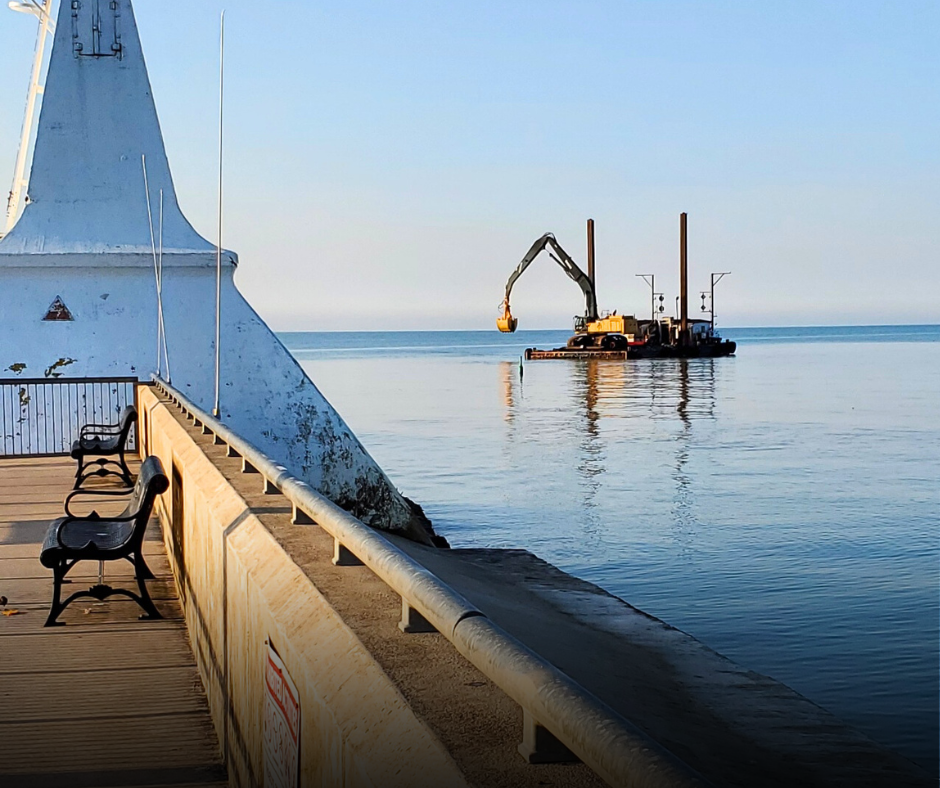
The Port Stanley Harbour Dredging Operations have started!
The dredging will start at the mouth of the Harbour and at the lighthouse, extending upstream to the King George VI Lift Bridge. The dredged material will be loaded onto bottom dump scows and deposited east of Port Stanley Harbour in the lake.
Weekday dredging will take place round the clock, subject to weather conditions. Please note that weekend work will only be scheduled if necessary due to weather conditions and to ensure the completion of the project by November 1, 2023.
We kindly request your cooperation during the dredging operations by adhering to the following guidelines:
- Keep a safe distance from the dredging operation and the scows transporting the dredged material.
- Reduce your speed and exercise caution to minimize wake when near the dredging area.
To address some common questions from the public about this project, we'd like to take a moment to provide answers that may also help others with similar concerns.
Harbour Dredging FAQ
|
Why is the Port Stanley Harbour being dredged? |
|
Dredging of Port Stanley Harbour is necessary to control floods in the lands adjacent to Kettle Creek, which includes the Bessie, Maud, Main Street areas, and properties upstream of the King George VI Lift Bridge. The constant erosion in the Kettle Creek watershed causes sediment to be deposited in the harbour, carried by Kettle Creek and accumulating there. As these sediments fill up the harbour, the space between the seawalls along the harbour decreases, reducing the capacity to handle water during heavy rainfall. To illustrate this, imagine pouring your favorite canned beverage into a glass. The glass can hold the entire contents of the beverage, but if you add ice to the glass first, it can no longer accommodate the entire beverage. If you continue pouring, your drink will spill over onto the counter. Similarly, the pier walls of the harbour are like the glass, and the dredging process removes the sediments (similar to the ice) to create room for the water during high runoff situations. This ensures that the harbour can effectively handle excess water and prevent flooding in the adjacent areas.
|
|
Where is the dredged material going in 2023? |
|
In 2023, the material dredged from the Harbour is being deposited in Lake Erie. There are two dumpsites located close to the shore. The first dumpsite is approximately 3 km east of the Harbour, and the second dumpsite is approximately 6 km east of the Harbour.
|
|
Why is the dredged material being deposited in the Lake? |
|
Lake disposal is currently the most economical way of disposing of dredged material. This may change in the future giving the ever-increasing environmental regulations imposed on the municipality by upper levels of government.
|
|
Is the dredging operation responsible for poorer water quality in Lake Erie? |
|
No. The natural current, or Lateral Drift, of Lake Erie in Port Stanley typically flows from the west to the east. Sediments from the western part of Port Stanley are carried eastward and get trapped along the west breakwater, adjacent to little beach. During periods of high southwest winds, which cause increased waves and are often accompanied by warmer weather, these sediments release the bacteria bound to them. Consequently, this can lead to a decrease in water quality in the area.
|
|
Why could the Harbour dredging not start in early spring when it was not as busy? |
| All dredging activities, including removal and dumping, take place in water, and this is considered fish habitat. In Canada, the Federal Fisheries Act is responsible for regulating such activities and is administered by the Department of Fisheries and Oceans.
As a protective measure for fish spawning season, the Fisheries Act prohibits in-water works before July 15. Therefore, no dredging work can be undertaken prior to this date. However, the municipality sought approval from the Department of Fisheries and Oceans to begin work before July 15. After consideration, the Department of Fisheries and Oceans granted permission to start the dredging activities, but not earlier than July 1.
|
|
How often is the Harbour dredged? |
|
The timing of dredging is determined by the amount of sediment accumulated in the Harbour due to runoff from upstream in the Kettle Creek Watershed. Usually, dredging is required every six to 8 years to maintain the Harbour's navigability and capacity. The last dredging operation took place in 2015/2016, during which land-based techniques were employed, allowing the possibility of conducting dredging during the winter months. The dredged material from this project was utilized to create what is now known as Hofhuis Park. It's interesting to note that Hofhuis Park was once underwater before the dredging transformed it into the park we see today.
|
